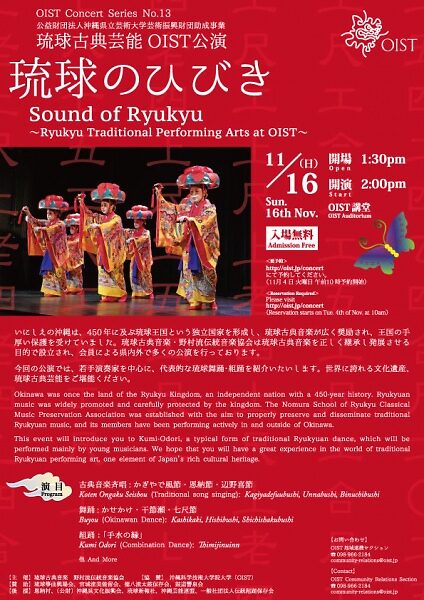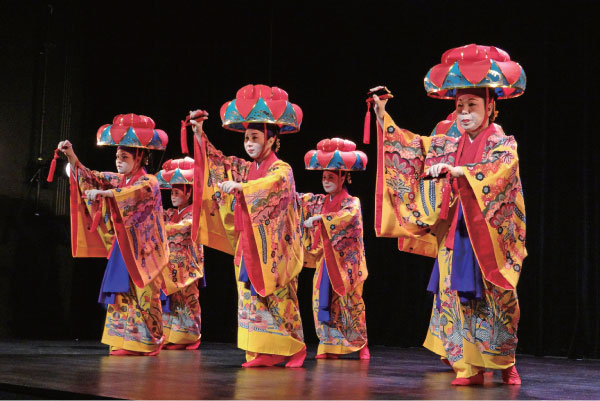Sound of Ryukyu - Ryukyu Traditional Performing Arts at OIST

Date
Location
Description

OIST Concert Series No. 13
琉球のひびき Sound of Ryukyu - Ryukyu Traditional Performing Arts at OIST
Nov 16th at 14:00 in the OIST Auditorium (Doors open 13:30)
Registration required. Registration starts Nov 4th at 10am.
Reserve your seat at https://www.oist.jp/concert
Okinawa was once the land of the Ryukyu Kingdom, an independent nation with a 450-year history. Ryukyuan music was widely promoted and carefully protected by the kingdom. The Nomura School of Ryukyu Classical Music Preservation Association was established with the aim to properly preserve and disseminate traditional Ryukyuan music, and its members have been performing actively in and outside of Okinawa.
This event will introduce you to Kumi-Odori, a typical form of traditional Ryukyuan dance, which will be performed mainly by young musicians. We hope that you will have a great experience in the world of traditional Ryukyuan performing art, one element of Japan’s rich cultural heritage.
Ryukyu Traditional Music
Ryukyu Traditional Music is a general term for various forms of Ryukyuan court music used in Kumiodori and traditional dances. In addition to Sanshin, an Okinawan three-stringed instrument, Ryukyu traditional music employs a number of other instruments, including koto, flute, Chinese fiddle, and drums. It is characterized by its solemn and dignified sound.
Kumi Odori
Kumiodori was founded by Chokun Tamagusuku, the odori-bugyo, or dance magistrate, of the Ryukyu Kingdom. It is a form of stage drama consisting of three elements: script, music and song, and dance. In 1972, as a testimony to the uniqueness of this art form, kumiodori was designated as an important intangible cultural asset and registered as a UNESCO intangible cultural heritage in 2010.
Ryukyu Dance
Ryukyu Dance is one of the Ryukyuan traditional performing arts and a general term for dance forms presently being practiced and handed down to future generations in Okinawa. Ryukyu-Buyo usually includes several musical numbers embracing various styles of Ryukyuan traditional music. While originally performed only by male dancers, many female dancers have emerged since the Meiji Era, especially in the postwar period. Ryukyu-Buyo can be broadly classified into koten-odori (traditional dance), zatsu-odori (common dance), and sosaku-buyo (creative dance).
Okinawan Folk Songs
Okinawan folk songs originated from traditional music and gradually became popular. There have been many colorful songs that convey excellent narratives.
Folk Performing Arts
Diverse folk performing arts have been carefully passed down from generation to generation since ancient times in different parts of Okinawa. Typical forms include Eisa Dance, Shishimai (lion dance), Bo-Odori (stick dance), Drama, and Buyo (Dance), which are performed at various events around the prefecture.
Okinawa Plays
Okinawa Plays has been loved and appreciated by people of many generations. It is divided into two main types. One is Kageki (Opera) that combines scripts suitable for Okinawan folk songs and classical music and dance. The other is “Dialect-spoken Play,” in which the Ryukyu dialects are spoken.
Website URL
Attachments
Subscribe to the OIST Calendar: Right-click to download, then open in your calendar application.



